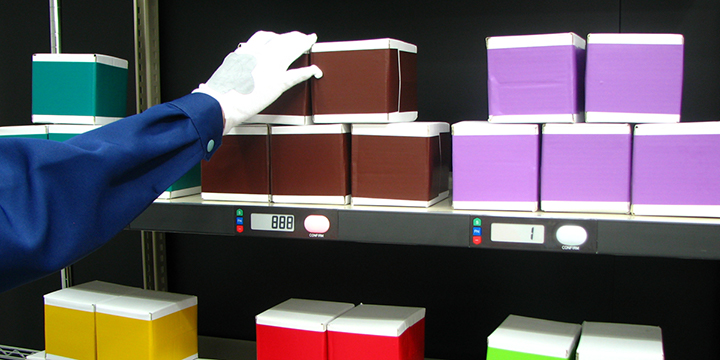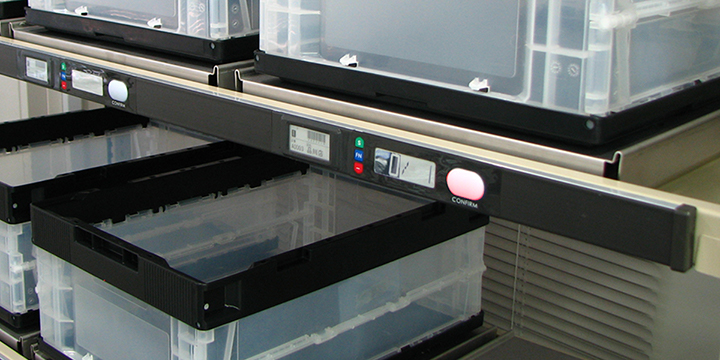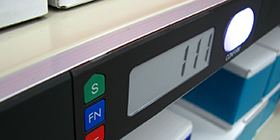Pick to Light systems refers to a picking assistance system that uses Light Module. Workers at a factory or distribution center walk to the locations of illuminating Light Module and take out items by the displayed quantities. Items can be picked accurately and quickly according to the instructions given by the Light Modules.This chapter will explain the effect of introduction and evolution of Pick to Light.
Pick(Put) to Light System
“Digital picking system (DPS)” is a Japanese-English term referring primarily to picking instruction systems for products and parts. In the U.S., similar systems called “Pick To Light (PTL)” have been in use since the 1970s.
The first DPS was introduced by a Japanese automaker in the 1960s, which was a lamp guide system consisting of lamps and switches connected to a sequencer (Programmable Logic Controller, or PLC) to assist the picking of parts. Initially, DPSs were used by warehousing-type distribution centers (DC) to pick orders for volume-discount stores, each carrying many items bound for many different shipping destinations. They were also used as part picking systems at manufacturing processes.
Picking of products and parts was not the only application for DPSs. These systems were also adopted for assorting products for different orders. In particular, “DPS” became a keyword at transfer-type distribution centers (TC) in assorting products as soon as they were received from vendors.
Systems used for assorting operations are called “Digital Assorting Systems” (DAS) in Japanese-English, and “Put To Light” (PTL) systems in the U.S. and Europe. Both DAS and PTL systems enjoy a high reputation for significantly improving the efficiency of logistic operations by increasing productivity 2-fold and picking accuracy by 10-fold compared to the traditional list systems which require workers to hold a shipping instruction list (picking list or assorting list) in their hands and pick items according to the list.
- Pick-and-check system that inspects POS items as they are picked
- Poka-yoke screen that checks for location errors by detecting the position of a worker’s hand
- Weight assorting system that checks the weight of items as they are assorted by using checking devices placed at each location on shelves that are linked to a network
We try to offer various solutions like those listed above to meet individual customer’s need. The customer can select the most cost-effective system according to the attributes of their products and characteristics of their logistic operations.



Approach to Power-saving

Reduced power consumption of home appliances and electric and electronic devices have become increasingly important when it comes to preserving the environment and reducing energy consumption. Along with the evolution of network technology, products such as e-books and other new display media are now widely used.
To reduce power consumption, AIOI developed the electronic paper display, “eP module,” to replace the JW series using traditional LED displays. Consuming substantially less power and displaying barcode and images in addition to numbers and characters, eP modules are opening the door to diverse application possibilities besides Pick to Light systems.
Data displayed on eP modules can be rewritten every time their locations on product or assorting shelves are changed, so there is no longer a need for traditional labels, such as shelf number labels, product labels, and shipping destination labels that must be printed on paper and attached to the shelves. eP modules are paperless, smart display systems that replace single-use paper labels.
Challenge to the Free-location and Mobile Needs

AIOI-SYSTEMS also has been developing a line of wireless-communications display systems to meet the free-location and mobile needs of the marketplace. One disadvantage of traditional 7-segment LED displays is that they consume excessive electricity and must be charged almost daily. To address this issue, AIOI quickly adopted electronic paper technology and developed a power-saving display. The NW series of wireless display can operate continuously for about one month with three fully-charged AA batteries.
These wireless displays are finding their way not only into free-location systems, but also into mobile systems that issue work instructions as they move. Our pursuit of paperless operations to improve work productivity and accuracy has also eliminated the need for printers. Our wireless display technology literally killed two birds with one stone by fulfilling the needs for resource and energy efficiency, a key theme in today’s marketplace
AIOI-SYSTEMS will continue to drive the evolution of Pick to Light systems and operation support systems to meet the needs of our customers and their manufacturing and logistics operations.
